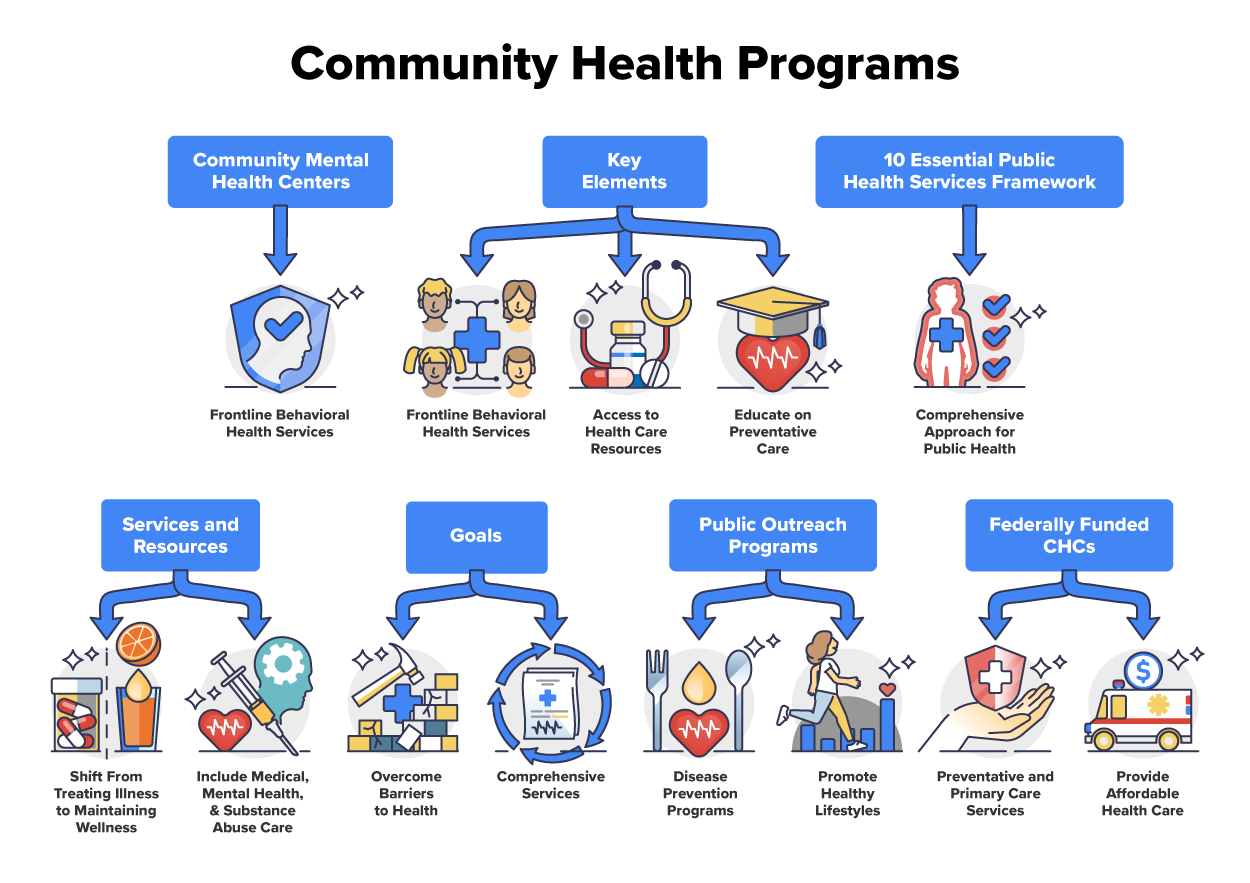Table of Contents |
Many times, you will hear the construct of health described as consisting of multiple dimensions. These dimensions have various names but consist of physical health, emotional health, environmental health, occupational health, spiritual health, intellectual health, social health, behavioral health, and mental health. Some other disciplines may use other labels for these dimensions or describe fewer layers. This lesson will focus only on social, behavioral, and mental health dimensions. Dimensions of health, in this sense, mean layers of health and well-being. Each dimension has features that distinguish one from the other. However, each dimension does directly affect the outcomes of the others. The interconnectedness of each of these dimensions and how they affect the health of individuals and communities will also be discussed.
The social dimension of health refers to the relationships or connections we all have with others. Relationships have an impact on our lives, and their effects can be positive, negative, or somewhere in between. Positive relationships cultivate meaningful and healthy bonds between people. In the social dimension of health, positive relationships create a sense of connection and belonging within communities, groups, and populations. Having people who care about us creates a sustained social support system that fosters a healthy social response when there is a crisis (Mao et al., 2024). This social dimension of health is directly affected by the emotional dimension, and vice versa. Being able to express our emotions appropriately to others can help us to effectively cope with life’s difficulties. In public and community health, this is especially true when a tragedy, such as a school shooting or natural disaster, strikes a community.
IN CONTEXT
Social Dimension of Health During the Pandemic
When news of the pandemic spread, anxiety and uncertainty gripped communities. There were lockdowns, and people began to isolate themselves. This disrupted routines and prevented people from gathering with family, friends, and coworkers. The nature of social support changed when the sudden shift from in-office work to remote work meant that homeschooling, household chores, and managing family members became overwhelming for many individuals. Neighbors began helping each other in ways they never did before. Social support could be found in activities such as childcare, grocery shopping, and virtual tutoring for the kids. Neighbors took turns checking on isolated seniors who were confined indoors. Video calls, puzzles, and books were sometimes shared to ease the loneliness. Unlikely support systems developed and could help ease fear and isolation.

Earlier in this course, you learned about how the lifestyle choices we make can directly affect health and, by extension, mental health. You also learned that behavioral indicators are specific markers within leading health indicators (LHIs) that refer to lifestyle-related behaviors like physical activity levels, smoking, and dietary habits. When these indicators are monitored, they help to assess risks to overall health status.
Behavioral health refers to choices around health behaviors that place us at risk for ill health or that help us maintain good health. Behavioral health also encompasses psychological and social well-being, including individual thoughts, feelings, and behaviors, like the ability to cope with stress and regulate emotions. Indicators of positive behavioral health include open-mindedness, intellectual growth, and emotional coping, which help us make decisions that protect our health, like choosing not to smoke and avoiding the use of substances that lead to addiction. Lifestyle and health behaviors that consider daily habits and activities promoting well-being are indicators of positive behavioral health.
Public and community health approaches to behavioral health, as discussed previously around behavior change models like the socio-ecological model, consider building skills in how to navigate life stressors and crises, recognizing how stress affects the body and using coping mechanisms that promote healthy outcomes. Behavioral health involves the prevention, diagnosis, and treatment of issues arising around lifestyle choices that help us prevent, maintain, or restore health. The integration of medicine and behavioral health services helps promote accessible and equitable treatment while reducing the stigma that can be associated with seeking help for behavioral and related mental health issues. This integration-of-services approach is essential to advancing overall well-being and providing patient-centered care (American Medical Association, 2024).
Mental health refers to a person’s state of mental well-being, regardless of whether they have a psychiatric condition like depression. It is not limited to the absence of mental illness but encompasses overall emotional and psychological health (Holmes, 2023). It refers to the state of emotional, psychological, and social well-being. Mental and physical health are equally important components of our overall health.
EXAMPLE
Depression increases the risk for several chronic conditions, including diabetes and heart disease (Centers for Disease Control and Prevention [CDC], n.d.).Mental health plays a crucial role in public and community health. Public health, as you have learned, aims to promote healthy lifestyles and detect, prevent, and respond to diseases. Given the prevalence of mental health issues that significantly impact individuals, families, and communities, addressing mental health becomes essential in achieving public health objectives. Poor mental health can lead to social and physical problems with serious impacts (Tulane University, 2021). For example, a clear relationship exists between mental health issues and substance use and misuse. Each can lead to the other.
Families that have a family member suffering from mental health issues are also affected financially and emotionally. Dealing with a loved one’s mental health issues can be exhausting, and seeking treatment can exhaust resources. Children with family members experiencing mental health issues may blame themselves for the problem, which can lead to loneliness and feelings of being different (Tulane University, 2021).

Mental health issues often have a genetic component, which means certain conditions tend to run in families. Having a close relative with a mental health issue can increase family members’ risks of developing one. However, there are many other factors other than genetics that play a role.
EXAMPLE
Environmental influences include upbringing, childhood experiences, and trauma associated with living in violent neighborhoods.EXAMPLE
Lifestyle choices like poor diet, lack of exercise, and substance use; lack of stress management related to work; caregiving; or ongoing health issues can all play roles.As mentioned earlier in this lesson, family dynamics and social relationships can impact mental health. Recognizing symptoms of mental health issues and seeking professional help is important. Knowing your family’s mental health history provides insights to help you and your health care provider identify risks and promote early detection to take proactive steps toward mental well-being. Mental health is important at every stage of life: childhood, adolescence, and adulthood (CDC, n.d.).
Mental health stigma is when people see and treat someone with a mental health issue negatively. Stigmatizing mental health often stems from a lack of understanding and can lead to discrimination against people with mental health issues. It can manifest in subtle or overt ways. Stigma involves discrediting people because of their mental health differences, which can lead to feelings of shame or worthlessness. Public stigma refers to the negative attitudes and discriminatory beliefs held by others about mental health issues. Self-stigma refers to the negative attitudes and internalized shame that individuals with mental health issues have about their own condition (American Psychiatric Association [APA], n.d.). Institutional stigma refers to organizational policies that unintentionally limit opportunities for people with mental health issues.
EXAMPLE
A public or private agency allocating lower levels of funding for research that studies people with mental health issues or fewer health care services related to mental health as compared to other services is a form of institutional stigma (APA, n.d.).Stigma can marginalize people with mental health issues, making them feel excluded and discriminated against. The fear of being treated differently prevents people from getting help. Stigma can also vary across racial and ethnic communities (APA, n.d.).
Addressing issues related to social, behavioral, and mental health requires a multifaceted approach. Addressing social, behavioral, and mental health is not limited to individual therapy. It extends to frameworks designed to address behavior change and mental health at the population-health level. Public health agencies incorporate social, behavioral, and mental health promotion into chronic disease prevention efforts; conduct surveillance and research; and collaborate to enhance coordination of care. Treatment for social, behavioral, and mental health is available and effective, but most people with issues related to social, behavioral, and mental health do not receive treatment (Henderson et al., 2013).
The challenges for public and community health are to identify risks and increase awareness about social, behavioral, and mental health issues and the effectiveness of treatment. Reducing or removing the stigma associated with social, behavioral, and/or mental health issues is also important. It is imperative to eliminate health disparities and improve access to health services for all persons, particularly among populations that are disproportionately affected.

Public and community health professionals create programs that address the factors that contribute to poor health or focus on evidence-based interventions known to foster good social, behavioral, and mental health. Identifying risks to health, such as chronic health conditions and trauma, is important in prevention programming.
EXAMPLE
Programs by population might include programs for older adults that reduce isolation through offering social activities. Also, programs that challenge social norms, reduce risk factors around violence, and cultivate resilience will improve community health violence initiatives, which could then reduce violence within communities.Further, public and community health professionals can advocate for policies that foster positive social, behavioral, and mental health and help people thrive. Building evidence through research that identifies prevention strategies and intervention methods can also lead to the development of the most effective prevention and treatment methods to improve health outcomes (Tulane University, 2021).
IN CONTEXT
Project ALERT
One example of a population-specific, evidence- and school-based prevention program for adolescent substance use is called Project ALERT. ALERT is an acronym for Adolescent Learning Experiences in Resistance Training. This program is targeted at middle-school-aged children and is offered in a classroom setting. Research has shown that at this age, most kids have not initiated substance use. By beginning to build resistance skills to refuse to use at this stage, public and community health initiatives using this program will aim to prevent this population from ever initiating use. The program’s goals are to teach middle schoolers how to build the skills to resist initiating the use of alcohol, tobacco, and other drugs even if pressured to do so by family or friends.
This is one among many evidence-based programs used as a strategy in communities to reduce harm from using substances.
Public- and community-health-based efforts foster resilience; improve social, behavioral, and mental health outcomes; and create supportive environments for all.
Source: THIS TUTORIAL WAS AUTHORED BY SOPHIA LEARNING. PLEASE SEE OUR TERMS OF USE.
Disclaimer: The use of any CDC and United States government materials, including any links to the materials on the CDC or government websites, does not imply endorsement by the CDC or the United States government of us, our company, product, facility, service, or enterprise.
REFERENCES
American Medical Association. (2024, August 22). What is behavioral health? www.ama-assn.org/delivering-care/public-health/what-behavioral-health
American Psychiatric Association. (n.d.). Stigma, prejudice and discrimination against people with mental illness. www.psychiatry.org/patients-families/stigma-and-discrimination
Centers for Disease Control and Prevention. (n.d.). About mental health. www.cdc.gov/mentalhealth/learn/index.htm
Henderson, C., Evans-Lacko, S., & Thornicroft, G. (2013). Mental illness stigma, help seeking, and public health programs. American Journal of Public Health, 103(5), 777–780. doi.org/10.2105/AJPH.2012.301056
Holmes, L. (2023, April 13). What is mental health? Verywell Mind www.verywellmind.com/what-is-mental-health-2330755
Mao, Y., Chen, J., Liu, X., Dang, J., & Schiöth, H. B. (2024). Social support predicted subsequent subjective well-being during the COVID-19 pandemic: A prospective study. BMC Public Health, 24(1), 943. doi.org/10.1186/s12889-024-18473-2
Tulane University. (2021, January 13). Understanding mental health as a public health issue. Tulane University School of Public Health and Tropical Medicine Blog. publichealth.tulane.edu/blog/mental-health-public-health